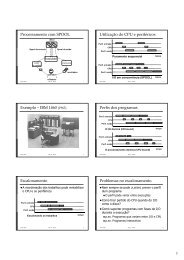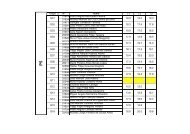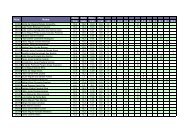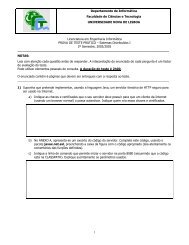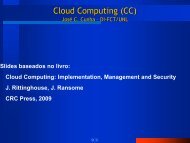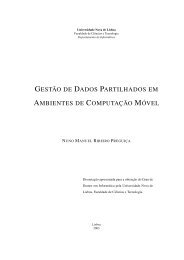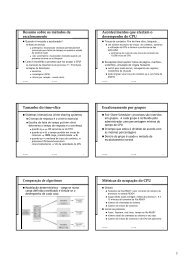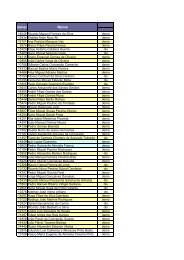Dissertaç ˜ao de Mestrado Mestrado em Engenharia Informática Jo ...
Dissertaç ˜ao de Mestrado Mestrado em Engenharia Informática Jo ...
Dissertaç ˜ao de Mestrado Mestrado em Engenharia Informática Jo ...
Create successful ePaper yourself
Turn your PDF publications into a flip-book with our unique Google optimized e-Paper software.
1. INTRODUCTION 1.1. Motivation<br />
sible to gather several un<strong>de</strong>rutilized servers into fewer ones (possibly just a single server) by<br />
virtualizing the hardware where each server runs. This reduces not only the companies’ electri-<br />
cal bills, but also cooling, space and hardware costs. Virtualization brings along other benefits<br />
such as the fast replication and/or migration of virtual machines (VMs), which allows for high<br />
availability of the services provi<strong>de</strong>d by the VMs.<br />
But not only the final users of virtualization woke up to the trend. Some IT giants such as<br />
Intel, AMD and Microsoft already entered the virtualization market, with different solutions<br />
such as hardware-assisted virtualization or hypervisor based virtualization. This huge trend<br />
also got into the consumers market, with popular solutions such as VMware Workstation or<br />
Microsoft Virtual PC, and even in the gaming market. Anyone who runs games on MAME<br />
or WINE is using virtualization technology. Currently, there are a lot of virtualization solu-<br />
tions in the market. These inclu<strong>de</strong> VMware [VMw09], XenSource [Cit09], Microsoft [Mic09a],<br />
Sun [Mic09c], Parallels [Par09] products, and so on.<br />
With the advanc<strong>em</strong>ent of virtualization technology, the new Virtual Appliance (VA) concept<br />
<strong>em</strong>erged. VAs came to change the way of looking to software <strong>de</strong>ployment. Unlike the existing<br />
software <strong>de</strong>ployment mo<strong>de</strong>ls, presented ahead in Section 2.1, such as the traditional CD-ROM<br />
way, Software as a Service or Hardware Appliances, VAs allow the costumers to have their<br />
own IT platform, fully optimized for the task being and completely un<strong>de</strong>r their domain. The<br />
blending of virtualization benefits with VAs’ performance is bringing software <strong>de</strong>ployment to<br />
a new level.<br />
This shift in the IT sector motivated project VIRTU [Sol09a] which is a collective effort by<br />
the consortium composed of Evolve Space Solutions, Universida<strong>de</strong> Nova <strong>de</strong> Lisboa, Universi-<br />
da<strong>de</strong> <strong>de</strong> Coimbra, HP Labs and the European Space Agency. The project’s goal is to <strong>de</strong>velop an<br />
open-source vendor-in<strong>de</strong>pen<strong>de</strong>nt virtualization platform, including support for the manage-<br />
ment and configuration of applications.<br />
There are currently two <strong>em</strong>erging opportunities on the IT market. On one si<strong>de</strong>, virtualiza-<br />
tion has changed the way in which companies <strong>de</strong>ploy software, on the other hand, application<br />
configuration is still mostly a manual task. VIRTU exploits these opportunities by <strong>de</strong>fining a<br />
virtualization tool which manages application stacks. In other words, VIRTU allows for the<br />
creation of optimized virtual machines ass<strong>em</strong>bled with existing applications which can be au-<br />
tomatically configured.<br />
VIRTU project’s use cases range from software testing in complex distributed syst<strong>em</strong>s, in-<br />
cluding the European Space Operations Center’s Mission Control Syst<strong>em</strong> (MCS) and Ground<br />
Syst<strong>em</strong> Tests and Validation infrastructure (GSTVi), to IT infrastructural manag<strong>em</strong>ent, like Por-<br />
tugal Telecom’s Application Service Provi<strong>de</strong>r or Novabase’s Enterprise Applications Environ-<br />
ment. VIRTU also makes it possible for a customer to have its solution self-provisioned within<br />
his domain, but also to maintain different application versions to achieve legacy compatibility.<br />
The advent of virtual appliances makes it possible to gather hundreds, or thousands of<br />
applications on the same machine. This results in many different ways to represent configu-<br />
rations, which, in turn, makes the manag<strong>em</strong>ent of those configurations complicated and time-<br />
consuming.<br />
2



